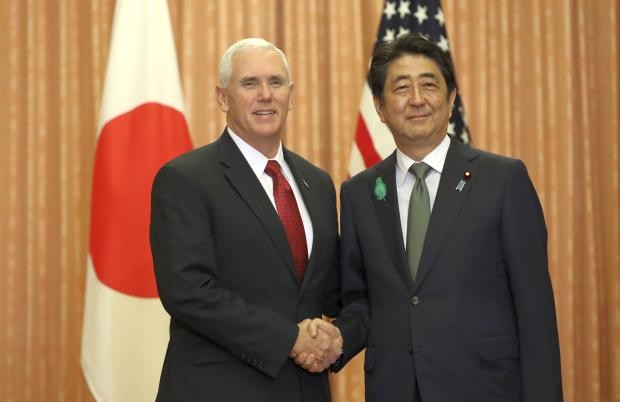Pence visits Japan, turning focus to trade with key ally

Japanese Prime Minister Shinzo Abe (right) and US Vice President Mike Pence shake hands prior to a luncheon hosted by Abe at the prime minister’s official residence in Tokyo, Tuesday, April 18, 2017. Pence arrived in Japan for talks Tuesday expected to focus largely on trade with America’s anchor ally in the region. (Pool photo by EUGENE HOSHIKO via AP)
TOKYO — US Vice President Mike Pence and Japanese leaders began talks Tuesday expected to focus largely on trade with America’s anchor ally in the region, though tensions with North Korea loomed large.
Pence reassured Prime Minister Shinzo Abe that the US considers its alliance with Japan to be a cornerstone of security in the region.
“We appreciate the challenging times in which the people of Japan live with increasing provocations from across the Sea of Japan,” Pence said.
“We are with you 100 percent,” he said, adding that the US “always seeks peace.”
Pence reiterated that after years of North Korea testing the US and its neighbors in East Asia with its nuclear ambitions, the US “era of strategic patience is over.”
Article continues after this advertisementAbe said Japan likewise hopes for peaceful dialogue with Pyongyang, “but at the same time, dialogue for the sake of dialogue is valueless.” Pressure on North Korea is crucial, he said.
Article continues after this advertisementPence is on a 10-day Asia trip that will also take him to Indonesia and Australia.
Concluding a visit to South Korea that was mostly focused on the North Korea problem, Pence told business leaders in Seoul earlier Tuesday that the administration is taking a fresh look at trade agreements as part of its “America First” policy.
“We’re reviewing all of our trade agreements across the world to ensure that they benefit our economy as much as they benefit our trading partners,” Pence told the American Chamber of Commerce in Korea.
White House officials said the economic meetings in Tokyo, with Deputy Prime Minister Taro Aso and other officials, will help forge a framework for a new US-Japan economic dialogue launched by President Donald Trump and Abe during the Japanese leader’s visit to the US in February.
Pence’s two main goals are to spur increased US access to Japanese markets and strengthen Japanese foreign investment, they said.
While Japan’s trade surplus with the US is much smaller than China’s, Trump has decried the imbalance, especially in auto exports.
Both sides said they do not expect the talks in Tokyo this week to delve into sector-by-sector talks on trade. With no US trade representative yet in office and other key negotiator positions still unfilled, such nitty-gritty discussions will have to come later.
But the meetings could indicate how forcefully the US will pressure Japan to further open its farm and automotive sectors.
Pence’s advisers said the vice president would make the case to Abe and Aso that the US rejection of the Trans-Pacific Partnership, or TPP, under Trump does not signal a US withdrawal from trade and economic development in the region.
The loss of US participation in the TPP was a blow to Japan following strenuous negotiations, especially over opening access wider to its long-protected farm sector.
Chief Cabinet Secretary Yoshihide Suga told reporters over the weekend that Japan might push ahead with a revised, 11-nation version of the TPP despite the U.S. rejection of the trade accord.
For now, both sides seem keen to downplay potential for conflict.
“My understanding is that our talks are premised not on friction but on cooperation,” Aso told reporters before Pence’s arrival.
US Commerce Secretary Wilbur Ross, who met with Japan’s trade minister, Hiroshige Seko earlier Tuesday, said he hopes to soon begin talks on a free trade agreement with Japan.
As Indiana governor, Pence saw firsthand the impact of Japanese automakers Toyota, Honda and Subaru, whose factories employ thousands of people in his home state.
* * *
Associated Press writer Mari Yamaguchi in Tokyo contributed to this report./rga